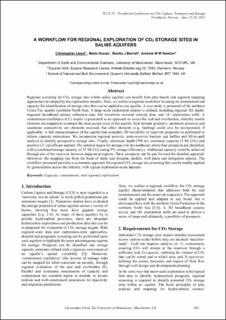| dc.description.abstract | Regional screening for CO2 storage sites within saline aquifers can benefit from play-based, risk segment mapping approaches developed by the exploration industry. Here, we outline a regional workflow focusing on containment and capacity for identification of storage sites that can be applied to any aquifer. A case study is presented of the northern Utsira Fm. aquifer (northern North Sea). A large-scale exploration dataset is utilised, including regional 3D, depthmigrated broadband seismic reflection data, full waveform inverted velocity data, and 141 exploration wells. A containment confidence (CC) matrix is presented as an approach to assess the seal and overburden, whereby matrix elements are mapped to constrain the most secure areas of the aquifer. Seal internal geometry, sandstone presence and sandstone connectivity are elements assessed, but other elements (e.g. faulting) could also be incorporated, if applicable. A full characterisation of the aquifer that considers 3D variability of reservoir properties is performed to inform capacity estimations. We incorporate regional porosity, intra-reservoir barriers and baffles and fill-to-spill analysis to identify prospective storage sites. Finally, minimum depth (700 m), minimum capacity (5 Mt CO2) and positive CC cut-offs are applied. The optimal region for storage is in the northeast, where four prospects are identified, with a combined storage capacity of 53 Mt CO2 (using 5% storage efficiency). Additional capacity could be achieved through use of the reservoir between adjacent prospects. These prospects can be put forward for detailed appraisal. Moreover, the mapping can form the basis of static and dynamic models, well plans and mitigation options. The workflow presented provides a systematic approach for regional CO2 storage site screening that can be readily applied by geoscientists across the industry, with typical exploration-scale datasets. | en_US |

